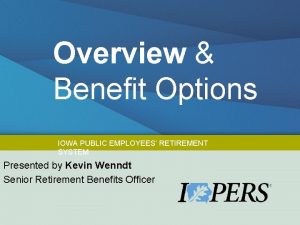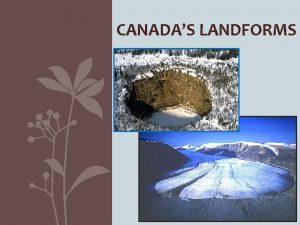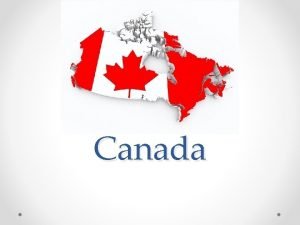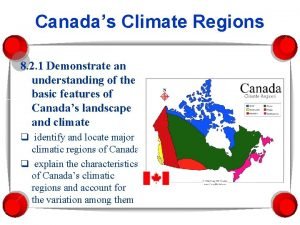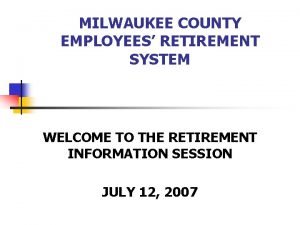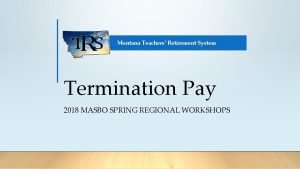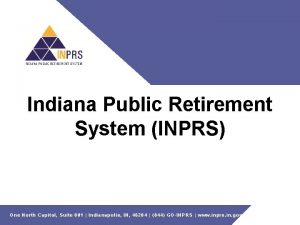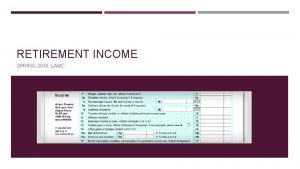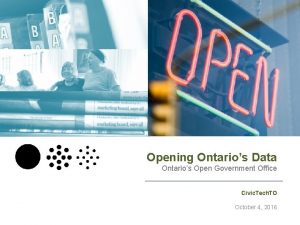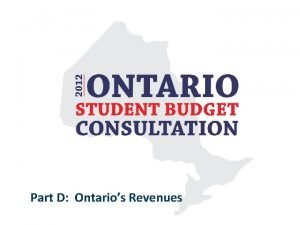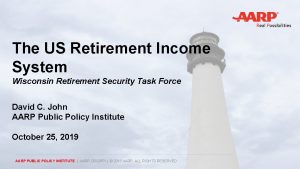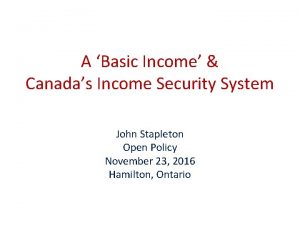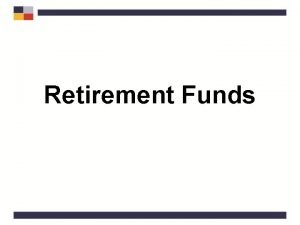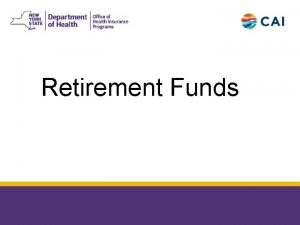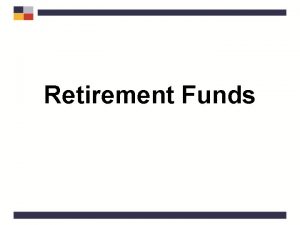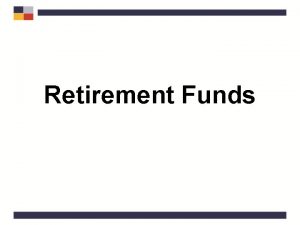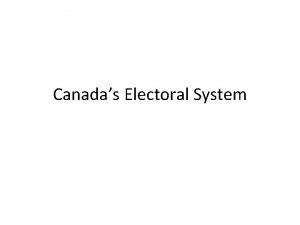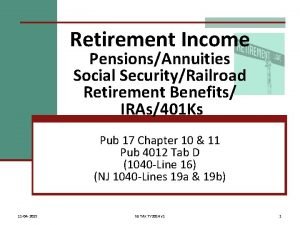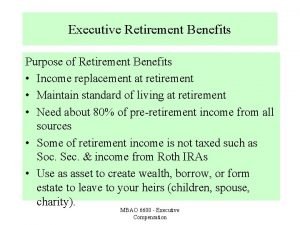Canadas Retirement Income System Issues and Options Ontarios

















- Slides: 17

Canada’s Retirement Income System: Issues and Options Ontario’s Public Consultations on Canada’s Retirement Income System Ottawa, Ontario May 6, 2010 Prepared by: Ontario Ministry of Finance Printed On:

Canada’s Retirement Income System: “The Three Pillars Approach” § Canada’s pension system consists of three pillars: 1. Universal government benefits for seniors (PILLAR 1) 2. Canada Pension Plan (PILLAR 2) 3. Employment Pension Plans and Individual Retirement Savings (PILLAR 3) 2

Canada’s Retirement Income System among OECD Countries “Old-age income safety-nets in Canada are amongst the highest in the OECD, helping Canada have one of the lowest poverty levels relative to average earnings. ” Figure 2. 5, OECD Pensions at a Glance, 2009 3

PILLAR 1: Universal Government Benefits § Federal seniors benefits include: 1. Old Age Security (OAS) 2. Guaranteed Income Supplement (GIS) 3. Spouses Allowance (SPA) Ontario (and other provinces and territories) supplement federal benefits to low-income seniors 4

PILLAR 2: Canada Pension Plan § Federal government and Provinces are joint stewards of the CPP § Provides retirement, survivor, and disability benefits § Universal coverage of all workers in all industries § Employees and employers make equal contributions (4. 95% each – 9. 9% combined) on earnings up to annual maximum of $47, 200 (2010) § Defined Benefit – up to 25% of the average wage § Fully portable § Inflation-indexed to CPI § Actuarially sound for the next 75 years § CPPIB invests assets of $123. 9 billion 5

6

PILLAR 3: Employment Pension Plans (EPPs/RPPs) & Individual Retirement Savings 1. Employment Pension Plans (EPPs/RPPs) § Voluntary plans sponsored by an employer or union § Defined Benefit (DB), Defined Contribution (DC) or Hybrid § Maximum DB pension accrual is $2, 494 per year of service (2010) § Subject to federal or provincial pension benefits standards legislation § Contributions are tax deductible and investment income is tax deferred § Benefits are taxable § Traditional DB coverage has been gradually declining 7

Ontario Employees Covered by DB Pensions Per Cent Sources: Statistics Canada, Pension Plans in Canada and Labour Force Survey. 8

PILLAR 3: EPPs/RPPs and Individual Retirement Savings 2. Registered Retirement Savings Plans (RRSPs) / Registered Retirement Income Funds (RRIFs) § Contributions to RRSPs are tax deductible § RRSP withdrawals and RRIF income payments are taxable § In 2006, federal RRSP tax expenditure was estimated at $10 billion (plus Provincial tax expenditures) 9

PILLAR 3: EPPs/RPPs and Individual Retirement Savings 3. Other Savings § Total savings rates in Canada are very low by historical standards § Average family savings of $1, 332 per year § Savings are accumulated and then dispensed over a person’s life cycle § Savings can be held in non-pension financial assets (including the new TFSA) and nonfinancial assets 10

Canada’s Retirement Income System: “The Three Pillars Approach” 11

Canadian Retirement Income System: Strengths § RIS has worked well for many Canadians q Dramatic declines in senior poverty since 1970 s § Diversity of the RIS is a strength 12

Canadian Retirement Income System: Challenges § Market downturn in 2008 and low long-term interest rates § Declining coverage in traditional pension plans § Pillar 2 (CPP/QPP) provides lower benefits than in most other developed countries § Questions about the ability of the existing system to deliver for tomorrow’s seniors § Research suggests that 1/4 to 1/3 of Canadians may not be savings enough for their future retirement. 13

Canadian Retirement Income System: Defining the Challenge § Ontario research identifies the challenge for tomorrow’s seniors: “The status quo is an option. However, it is an option that may leave a significant minority of people with moderate to high earnings facing a decline in their standard of living in retirement, and force many people to rely on sub-optimal pension and retirement savings institutions. ” - Bob Baldwin “There is… some evidence that not all working Canadians are saving enough… Further study is needed to determine the degree of saving inadequacy. - Jack Mintz 14

Canadian Retirement Income System: Government Response Expert Commission on Pensions q Review funding of DB pension plans and related matters § Bill 236, Pension Benefits Amendment Act, 2010 q First major pension reform in Ontario in over 20 years § Premier Mc. Guinty calls for National Pension Summit § FPT Working Group on Retirement Income Adequacy q Ontario research by Bob Baldwin q Federal research directed by Jack Mintz 15

Canadian Retirement Income System: Key Options § Major stakeholder proposals for reform: 1. Expansion of public pensions (CPP) 2. Supplementary DC pension plans 3. Pension Innovation 4. Reforms to Tax Assistance 16

Key Questions for Discussion § Why do we need to strengthen Canada’s retirement income system? q In your view what research or evidence demonstrates that people are not saving enough for retirement? q How would you define “enough”, and how much weight should be placed on personal choice? § What are some of the possible options or combination of options that the government should consider in strengthening Canada’s retirement income system for tomorrow’s seniors? § How would your preferred options or proposal be implemented? q How would your proposal work? q What do you think it might cost? q How would costs be allocated among employees, employers, etc. ? q Would it be voluntary (e. g. opt-out) or mandatory? q How might other stakeholders be affected? 17
 Ipers retirement options
Ipers retirement options What economic system is canada
What economic system is canada Temperatura en las cañadas del teide
Temperatura en las cañadas del teide Canadas landforms
Canadas landforms 90 of the canadian population lives within
90 of the canadian population lives within Whats canadas longest river
Whats canadas longest river Canadas 5 regions
Canadas 5 regions Who is canadas head of state
Who is canadas head of state Electromagnetismo
Electromagnetismo Physical regions in canada
Physical regions in canada Canadas climate
Canadas climate Calculate real gdp per capita
Calculate real gdp per capita Accounting income vs taxable income
Accounting income vs taxable income Multi step statement of comprehensive income
Multi step statement of comprehensive income Accounting income vs taxable income
Accounting income vs taxable income Milwaukee county retirements granted
Milwaukee county retirements granted Montana teachers retirement
Montana teachers retirement Inprs voya
Inprs voya
